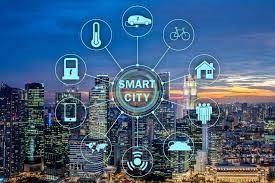The Future of 5G and IoT in Smart Cities
By Teal Communications–Keeping it simple, “smart cities” utilize emerging technologies such as 5G and IoT to create and deliver connected solutions for the well-being of a community. While the innovation of 5G technology will not facilitate the advancement of smart cities on its own, the new 5G infrastructure vastly expands the opportunity for cities to utilize smart devices, sensors, and data to improve operations and functions.

With 5G being the newest wireless technology, everything from smart sensors to self-driving cars can now communicate at incredibly fast speeds with low latency and without being tethered to an ethernet cable – resulting in more efficient systems and resources.
So, why is 5G technology vital to the advancement of smart cities?
- Public Safety and Security. Officers and emergency officials will be able to locate and receive real-time information regarding accidents and emergency calls from intelligent sensors that are placed throughout the city.
- Mobility. 5G networks will provide faster and lower latency connectivity for public transit systems, making it easier for autonomous vehicles and people to navigate cities.
- Traffic Management. The combination of 5G networks and IoT devices are expected to intelligently track and manage traffic flows, monitor road conditions, and reduce traffic congestion.
- Energy Efficiency. 5G creates huge opportunities for connected devices within buildings and cities to help track, monitor, and control energy. This helps buildings and cities better manage their energy supply, save money, and become more sustainable.
IoT
Along with 5G technology, the Internet of Things (IoT) is a key aspect to enabling a true, fully functioning smart city. In simple terms, IoT is a network of connected devices that communicate and exchange data – this can be anything from connected cars to street light sensors. IoT technology provides businesses, cities, and individuals with the ability to monitor, manage, and control these connected devices, while also gathering real-time data, analytics, and insights.
Some IoT applications in smart cities include:
- Energy Management
- Air Quality Management
- Traffic Monitoring & Management
- Connected Public Transport
- Connected Streetlights
- Weather Monitoring
- Waste Management
Smart Buildings and Smart Cities Integration
As IoT becomes more ubiquitous, smart buildings are becoming a larger and larger component of smart cities. While building owners and managers have always been on the lookout for new and better ways to reduce costs and improve energy efficiency, traditional building management systems (BMS) are becoming outdated amidst recent technological advancements. Why? Not only do wire-driven networks in buildings reach their data limits quickly, but they also result in higher costs and increased complexities. Today, smart buildings can leverage wireless technology, IoT devices, building automation, and data analytics to evaluate and monitor processes, while also operating more cost-effectively and efficiently.
Through IoT sensors, automation, and remote management, building owners and managers can deploy various devices across a facility to capture real-time data and insights regarding building management and functions, empowering them with unparalleled visibility into their building operations. Looking specifically at energy efficiency, facility owners and managers can now see exactly how and where energy is being used across a building.
Along with energy efficiency, wireless IoT sensors can monitor facility health and air quality. As people begin to return to the office post-pandemic, the importance of monitoring facility health and air quality is significant. In this regard, IoT sensors ensure building managers and businesses maintain a healthy working environment through advanced systems.
Finally, managing IoT security at scale is essential when it comes to data. In order to determine that IoT devices and networks remain secure and operational, asset management is crucial, as it provides regular and essential IoT security assessments.
Conclusion
5G and IoT are both key components for transforming how cities connect and operate. With IoT’s unlimited potential and 5G’s incredibly fast speeds and low latency, these technologies unleash critical infrastructure for the future of connected communities.
Thanks to the rollout and adoption of 5G and IoT, the future of smart cities will be more intelligent than ever – providing endless opportunities to communities that harness the power of edge computing, data, and machine-to-machine technologies.
Category: Uncategorized






